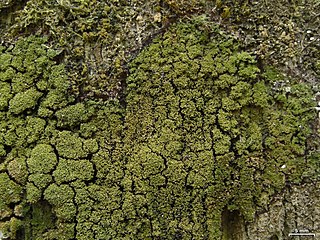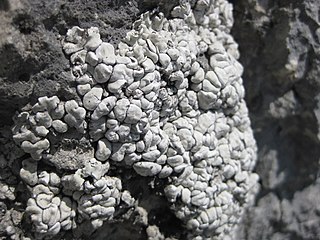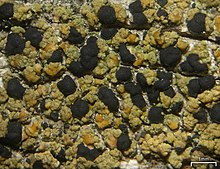
Psora is a genus of lichen-forming fungi in the family Psoraceae. Members of the genus are commonly called fishscale lichens. Lichens in the genus Psora are known to have a squamulose thallus and anthraquinones in the hymenium. Photobiont partners of Psora lichens include members of the green algal genera Asterochloris, Chloroidium, Myrmecia, and Trebouxia.

The Lecanorales are an order of mostly lichen-forming fungi belonging to the class Lecanoromycetes in the division Ascomycota. The order contains 26 families, 269 genera, and 5695 species.

The Lecanoraceae are a family of lichenized fungi in the order Lecanorales. Species of this family have a widespread distribution.
Adelolecia is a genus of crustose lichens in the family Lecanoraceae. The genus was circumscribed by Hannes Hertel and Josef Hafellner in 1984. The genus was formerly classified in the family Ramalinaceae, but molecular phylogenetic analysis showed it to belong to the Lecanoraceae.
Myelorrhiza is a genus of two Australian species of lichenized fungi in the family Ramalinaceae. It was circumscribed in 1986 by Australian lichenologists Doug Verdon and John A. Elix. Myelorrhiza was originally classified in the family Cladoniaceae until Kistenich and colleagues, using molecular phylogenetic analysis, showed that it is more appropriately placed with the Ramalinaceae.

Phyllopsora is a genus of lichen-forming fungi in the family Ramalinaceae. It was circumscribed by Swiss botanist Johannes Müller Argoviensis in 1894, with Phyllopsora breviuscula assigned as the type species.

Toniniopsis is a genus of crustose and squamulose lichens in the family Ramalinaceae. The genus was circumscribed by Swiss lichenologist Eduard Frey in 1926, with Toniniopsis obscura designated the type and only species. The genus name of Toniniopsis is in honour of Carlo Tonini (1803–1877), who was an Italian chemist and botanist (Lichenology), who worked in Verona and was a member and President of the Academy of Agriculture. As a result of molecular phylogenetic studies, several species, formerly classified in genus Bacidia, have been transferred to Toniniopsis.

Toninia is a genus of lichen-forming fungi in the family Ramalinaceae.

Calvitimela is a lichen genus in the family Tephromelataceae. Members of the family Tephromelataceae are crustose lichens with green photobionts and lecideine or lecanorine apothecia. The species in Calvitimela have lecideine apothecia, are saxicolous and are primarily found in alpine to arctic regions.

The Ophioparmaceae are a small family of lichen-forming fungi in the order Umbilicariales. The family was circumscribed in 1988 by lichenologists Roderick Westgarth Rogers and H. Thorsten Lumbsch.

Hypocenomyce is a genus of lichen-forming fungi in the family Ophioparmaceae. Species in the genus grow on bark and on wood, especially on burned tree stumps and trunks in coniferous forest. Hypocenomyce lichens are widely distributed in the northern hemisphere.

The Tephromelataceae are a family of lichenized fungi in the order Lecanorales. The family was circumscribed by Austrian lichenologist Josef Hafellner in 1984. Tephromelataceae comprises the genera Tephromela, Calvitimela, Mycoblastus and Violella, which together constitute a well-supported monophyletic group.
Bibbya is a genus of fruticose lichens in the family Ramalinaceae.

Sporastatiaceae is a small family of crustose lichens in the order Rhizocarpales. It contains two genera, Sporastatia and Toensbergia, with a total of five species. Sporastatiaceae was circumscribed in 2013 by Mika Bendiksby and Ernst Timdal.
Toensbergia is a genus of lichen-forming fungi in the family Sporastatiaceae. The genus was circumscribed by Mika Bendiksby and Einar Timdal in 2013. The genus name honours Norwegian lichenologist Tor Tønsberg, "in appreciation of his important work on sorediate, corticolous lichens". The type species is Toensbergia leucococca, which was formerly classified in genus Hypocenomyce, presumably due to its resemblance to Hypocenomyce xanthococca.

Rhizocarpales are an order of lichen-forming fungi in the subclass Lecanoromycetidae of the class Lecanoromycetes. It has two families, Rhizocarpaceae and Sporastatiaceae, which contain mostly crustose lichens.

Sporastatia is a genus of crustose lichens in the family Sporastatiaceae. It has four species. Sporastatia lichens are long-lived species that grow on siliceous or weakly calcareous rocks in arctic and alpine locales.

Carbonicola is a small genus of lichen-forming fungi. It is the sole genus in the monogeneric family Carbonicolaceae. The genus, which collectively has an almost cosmopolitan distribution, contains three squamulose lichens that prefer to grow on burned wood in temperate areas of the world.
Timdalia is a fungal genus in the family Acarosporaceae. It is a monotypic genus, containing the single species Timdalia intricata, a saxicolous (rock-dwelling), crustose lichen. This species was first formally described by Swedish lichenologist Adolf Hugo Magnusson in 1935, based on a collection made by Eduard Frey in Austria. It was initially classified in the genus Acarospora. Josef Hafellner circumscribed Timdalia to contain the species in 2001. It was initially placed in the family Lecanoraceae, but molecular phylogenetic studies showed Timdalia to belong in the Acarosporaceae. The genus name honours Norwegian lichenologist Einar Timdal.

Thalloidima is a genus of lichen-forming fungi in the family Ramalinaceae. It has 13 species.















